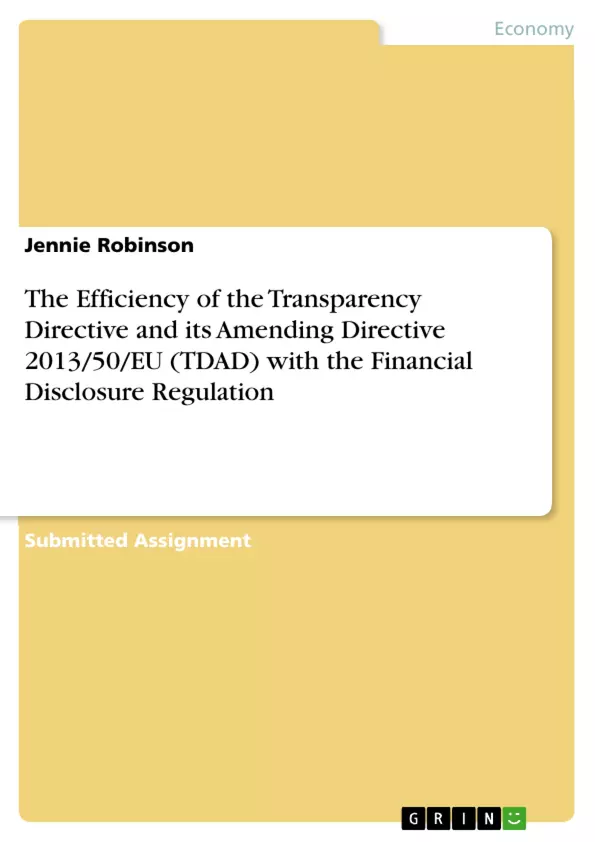Public disclosure of some of a company's financial affairs is an important requirement of a limited liability company. In this assignment, we will consider either the Transparency Directive and the Transparency Directive Amending Directive 2013/50/EU (TDAD) of the European Union has proven efficient in setting up the disclosure requirements regarding the financial information and distribution within the European Union, and in keeping with the rationale and objectives of financial disclosure regulation.
Inhaltsverzeichnis (Table of Contents)
- Introduction
- Development
- Limited Liability Company
- Public Disclosure
- The goals of the Financial Disclosure Regulation
- Efficiency of the EU Directives with the rationale and goals of the financial disclosure regulation
Zielsetzung und Themenschwerpunkte (Objectives and Key Themes)
This assignment examines the Transparency Directive and the Transparency Directive Amending Directive 2013/50/EU (TDAD) of the European Union, assessing their efficiency in establishing disclosure requirements for financial information within the EU and their alignment with the objectives of financial disclosure regulation. It explores the rationale behind the regulation and the need for public disclosure by limited liability companies, considering both its benefits and challenges.
- The importance of public disclosure by limited liability companies for investor and creditor protection
- The role of the Transparency Directive in achieving a single market for financial services and enhancing investor confidence
- The objectives of financial disclosure regulation, including investor protection, market efficiency, corporate governance, and public policy considerations
- The challenges and limitations of financial disclosure regulation, particularly in relation to public opinion and the effectiveness of financial statements in evaluating corporate management
- The legal framework surrounding limited liability companies, including their separate legal personality, limited liability, and the need for independent audits
Zusammenfassung der Kapitel (Chapter Summaries)
- Introduction: This section introduces the assignment's focus on analyzing the Transparency Directive and its amending directive in relation to financial disclosure requirements within the European Union. It emphasizes the importance of public disclosure for limited liability companies.
- Development: This chapter delves into the concept of a Limited Liability Company, outlining the significance of its separate legal personality and its members' limited liability. The role of directors in delivering statutory accounts and reports and the need for independent audits to ensure reliability are highlighted. The inherent need for transparency and publicity regarding a company's affairs is discussed.
- Public Disclosure: This section elaborates on the rationale behind public disclosure of financial affairs by limited liability companies. The objective is to empower investors and creditors with the necessary information to make informed judgments about the company's financial health. It emphasizes the role of annual audits, filing financial statements at the Companies House, and the importance of directors' reports in providing accountability and transparency.
- The goals of the Financial Disclosure Regulation: This chapter examines the objectives of financial disclosure regulation, including investor protection, market efficiency, corporate governance, and broader public policy considerations. It explores the arguments for and against each objective and the challenges of achieving them in practice.
- Efficiency of the EU Directives with the rationale and goals of the financial disclosure regulation: This section focuses on the Transparency Directive's objective of creating a single market for financial services and its alignment with the goals of financial disclosure regulation. It examines how the Directive aims to enhance both investor protection and market efficiency by promoting transparency and providing investors with timely and accurate information.
Schlüsselwörter (Keywords)
This preview of the text highlights key concepts such as Transparency Directive, financial disclosure, limited liability companies, investor protection, market efficiency, corporate governance, public policy, independent audits, and the role of directors in delivering statutory accounts and reports. The text delves into the EU's legal framework regarding financial transparency and its impact on the development of a single market for financial services.
- Quote paper
- Jennie Robinson (Author), 2016, The Efficiency of the Transparency Directive and its Amending Directive 2013/50/EU (TDAD) with the Financial Disclosure Regulation, Munich, GRIN Verlag, https://www.grin.com/document/432716



